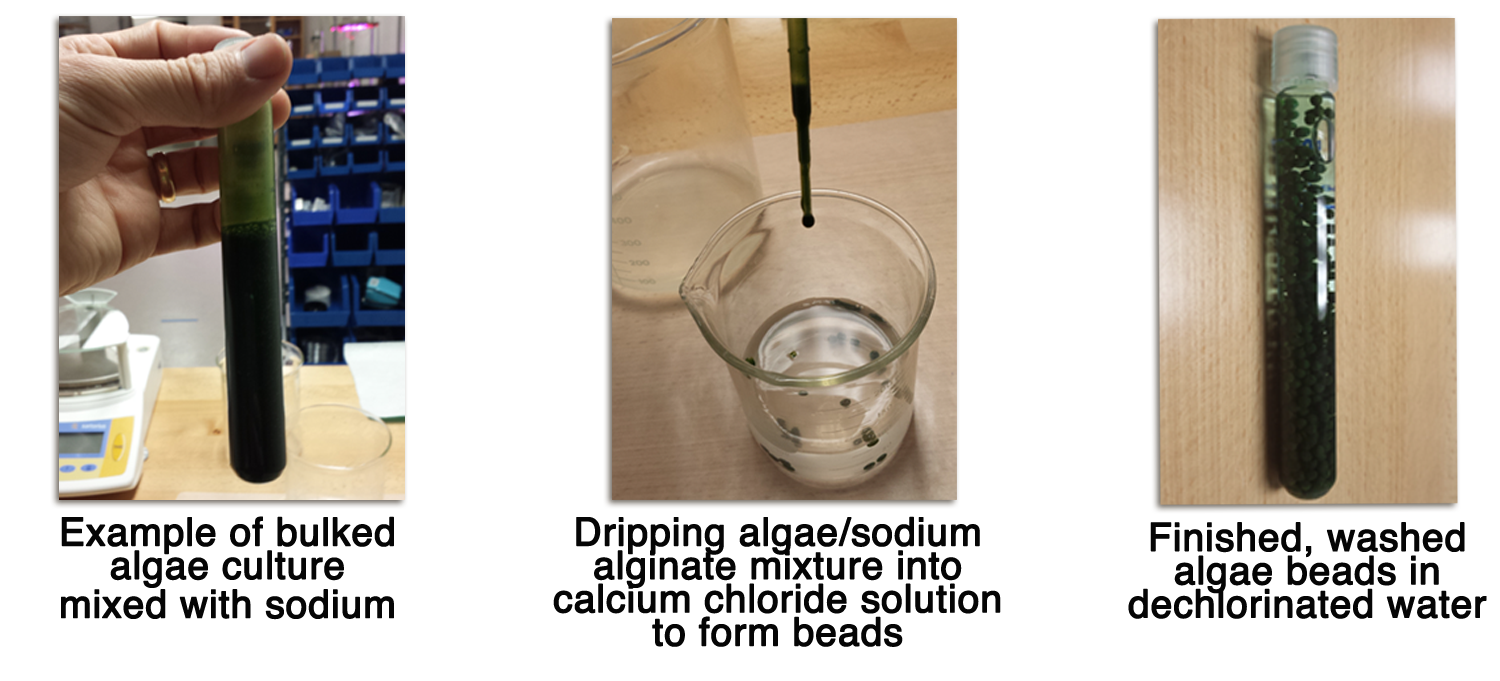Algaculture and Biofuel
Students will use the scientific method to learn about the growth properties of algae and how algae production may be a possible solution to address the global energy crisis. Students will utilize the engineering design process to apply their knowledge about algae growth to create a bioreactor for algae production and discover if biofuel can be made from algae.
Background
Lesson Activities
Recommended Companion Resources
Credits
Author
Joe Furse | National Center for Agricultural Literacy (NCAL)
Sources
- https://www.ncbi.nlm.nih.gov/pmc/articles/PMC4331613/
- https://manoa.hawaii.edu/exploringourfluidearth/biological/aquatic-plants-and-algae/what-are-aquatic-plants-and-algae
- https://www.epa.gov/nutrientpollution/harmful-algal-blooms
- https://oceancolor.gsfc.nasa.gov/SeaWiFS/TEACHERS/sanctuary_4.html
- https://www.sciencedirect.com/science/article/pii/S096195341200517X
- https://microbioengineering.com/blog/2017/2/24/backyard-biofuels-algae-production-in-pools-and-ponds
Background information compiled from:
- BP P.L.C. (2017). Statistical review of world energy. Retrieved from https://www.bp.com/content/dam/bp/en/corporate/pdf/energy-economics/statistical-review-2017/bp-statistical-review-of-world-energy-2017-full-report.pdf
- Chisty, Y. (2007). Biodiesel from microalgae. Biotechnology Advances, 25(3), 294-306. doi: 10.1016%2Fj.biotechadv.2007.02.001
- Hartman, E., (2008). A promising oil alternative: Algae energy. The Washington Post. Retrieved from http://www.washingtonpost.com/wp-dyn/content/article/2008/01/03/AR2008010303907.html
Standards
National Content Area Standards
- Career & Technical Education
- AFNR (Grades 9-12): Biotechnology Systems Career Pathway
- BS.02.03: Apply standard operating procedures for the safe handling of biological and chemical materials in a laboratory.
- BS.02.04: Safely manage and dispose of biological materials, chemicals and wastes according to standard operating procedures.
- BS.03.03: Apply biotechnology principles, techniques and processes to protect the environment and maximize use of natural resources (e.g., biomass, bioprospecting, industrial biotechnology, etc.).
- BS.03.05: Apply biotechnology principles, techniques and processes to produce biofuels (e.g., fermentation, transesterification, methanogenesis, etc.).
- AFNR (Grades 9-12): Environmental Service Systems Career Pathway
- ESS.01.02: Properly utilize scientific instruments in environmental monitoring situations (e.g., laboratory equipment, environmental monitoring instruments, etc.).
- ESS.04.04: Compare and contrast the impact of conventional and alternative energy sources on the environment and operation of environmental service systems.
- AFNR (Grades 9-12): Plant Science Systems Career Pathway
- PS.01.01: Determine the influence of environmental factors on plant growth.
- PS.01.02: Prepare and manage growing media for use in plant systems.
- PS.01.03: Develop and implement a fertilization plan for specific plants or crops.
- PS.02.02: Apply knowledge of plant anatomy and the functions of plant structures to activities associated with plant systems.
- PS.02.03: Apply knowledge of plant physiology and energy conversion to plant systems.
- PS.03.01: Demonstrate plant propagation techniques in plant system activities.
- PS.03.02: Develop and implement a management plan for plant production.
- PS.03.04: Apply principles and practices of sustainable agriculture to plant production.
- AFNR (Grades 9-12): Biotechnology Systems Career Pathway
- Science
- HS-ESS3: Earth and Human Activity
- HS-ESS3-3: Create a computational simulation to illustrate the relationships among the management of natural resources, the sustainability of human populations, and biodiversity.
- HS-ESS3-4: Evaluate or refine a technological solution that reduces impacts of human activities on natural systems.
- HS-ETS1: Engineering Design
- HS-ETS1-1: Analyze a major global challenge to specify qualitative and quantitative criteria and constraints for solutions that account for societal needs and wants.
- HS-ETS1-2: Design a solution to a complex real-world problem by breaking it down into smaller, more manageable problems that can be solved through engineering.
- HS-ETS1-3: Evaluate a solution to a complex real-world problem based on prioritized criteria and tradeoffs that account for a range of constraints, including cost, safety, reliability, and aesthetics, as well as possible social, cultural, and environmental impacts.
- HS-ETS1-4: Use a computer simulation to model the impact of proposed solutions to a complex real-world problem with numerous criteria and constraints on interactions within and between systems relevant to the problem.
- HS-LS1: From Molecules to Organisms: Structures and Processes
- HS-LS1-5: Use a model to illustrate how photosynthesis transforms light energy into stored chemical energy.
- APES Unit 6: Energy Resources and Consumption
- ENG-3.1 Energy from Biomass: Describe the effects of the use of biomass in power generation on the environment.
- HS-ESS3: Earth and Human Activity

